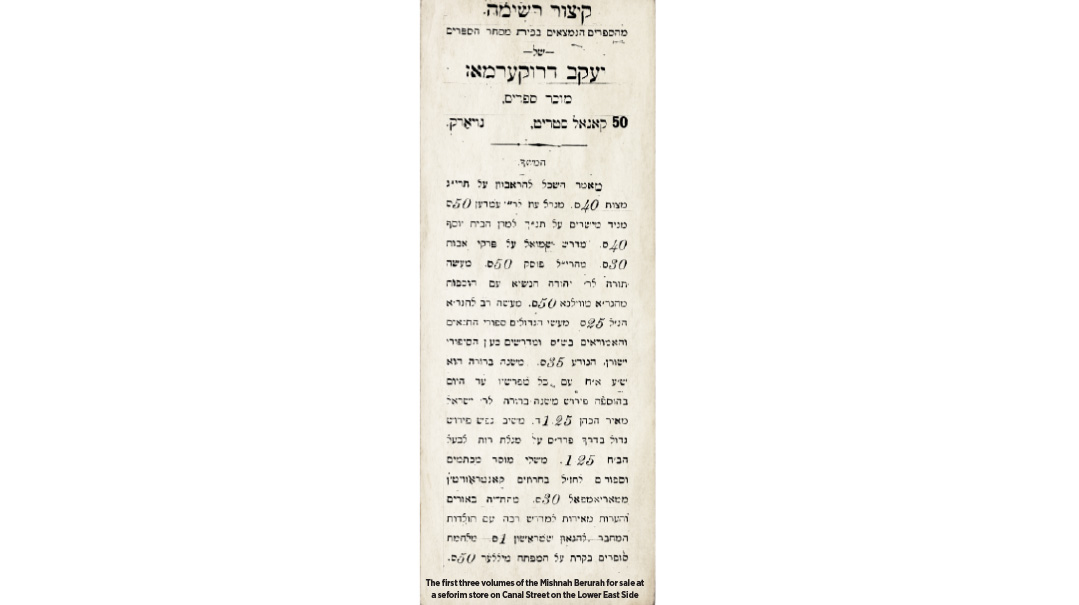The Chofetz Chaim Comes to Warsaw
| April 25, 2023The Chofetz Chaim spent significant time in Warsaw to oversee the publication of Mishnah Berurah

Title: The Chofetz Chaim Comes to Warsaw
Location: Warsaw, Poland
Document: Ha’Ivri
Time: Late 1800s
IN order to rectify this situation regarding halachic knowledge, I have, with Hashem’s assistance, compiled a satisfactory commentary on the Shulchan Aruch, currently through Hilchos Tefillah. I have named it Mishnah Berurah and have with Hashem’s help elucidated every din in the Shulchan Aruch through its source in the Gemara and poskim, so that it shouldn’t be a closed book.… My hope to Hashem is that through this commentary, every individual will find clarity in the study in all of its details.… Hashem should assist me in completing the commentary on the remainder of the halachos of this section of Shulchan Aruch, and He should strengthen my heart to serve Him. May we merit the comfort of Zion speedily in our days. Amen.
—Rav Yisrael Meir HaKohein, the Chofetz Chaim, introduction to the first volume of Mishnah Berurah, Warsaw 1884
The second half of the 19th century saw Warsaw’s Jewish community become the largest in Europe. The Industrial Revolution led to rapid urbanization, and the Jewish population of Warsaw skyrocketed from 11,000 in 1800 to more than 300,000 in 1910, making it second only to New York City.
One of the consequences of Warsaw’s growth as a Jewish metropolis was its central role in Hebrew publishing. By the end of the 1850s, eight Jewish printing houses were functioning in the Polish capital. So when the Chofetz Chaim embarked on the publication of his magnum opus Mishnah Berurah from 1884 to 1907, he spent significant time in the city to oversee its publication.
His host in Warsaw was Rav Yitzchok “Itche” Grodzinski, a legendary activist for Yiddishkeit and Jewish education. Rav Itche didn’t just host the Chofetz Chaim, he became his devoted follower and student, and later was known as the “Chofetz Chaim of Warsaw.” The Chofetz Chaim encouraged Rav Itche in his educational endeavors, which eventually grew into a vast network of schools, yeshivos, and batei medrash across the city.
One of Rav Itche’s most impressive accomplishments was Toras Chaim, one of the premier yeshivos in the capital during the decades of its existence. Aside from educational institutions, Rav Itche — with the Chofetz Chaim’s encouragement — established Torah frameworks for laborers in Warsaw. Rav Itche oversaw a Torah renaissance among the Warsaw working class. Batei medrash were established with regular shiurim on an array of topics.
Over the course of the quarter century the Chofetz Chaim devoted to writing the six volumes of Mishnah Berurah, he spent considerable time in Warsaw overseeing publishing and distribution. His integrity compelled him to supervise the process from beginning to end, and even after publication, he or a close family member would check each volume prior to sale for missing pages or glaring printing errors.
He even rushed back to Warsaw once and paid the printing house to change the lead type used for a specific page, as he had arrived at a different interpretation of a passage in Talmud Yerushalmi, and hence the halachah in the Mishnah Berurah would have to be duly modified.
Warsaw would also be the location of one of the aging and frail Chofetz Chaim’s final public appearances, as he met with Prime Minister Kazimierz Bartel in January 1930 regarding prospective reform in Jewish education. Throngs of Jews of all stripes lined the streets of the bustling metropolis to catch a glimpse of the universally beloved senior sage.
The Warsaw Ganev
The Chofetz Chaim was once approached on a Warsaw street by a stranger who requested four rubles change from a five ruble note, due to an outstanding debt owed from an earlier sefer purchase. Having no recollection of this debt, the Chofetz Chaim turned down the fellow’s attempt to give him the ruble as a gift, but relented to receiving it as a donation to his yeshivah.
When the Chofetz Chaim took out his wallet to find the change, the rogue snatched it and ran. The Chofetz Chaim restrained those who wished to chase the thief. “He’s probably in difficult circumstances, perhaps he has to marry off a daughter. Let him use my money in good health.”
From Warsaw Comes Forth Torah
Rav Itche Grodzinski’s son Rav Moshe served as the mashgiach of Toras Chaim, before settling in Eretz Yisrael, where he was tragically murdered in the Chevron massacre of 1929. Toras Chaim was headed by Rav Hirsh Glikson, son-in-law of Rav Chaim Brisker, for whom the yeshivah was named.
The yeshivah flourished in the years following Rav Itche Grodzinski’s passing in 1921, eventually reaching 300 students. Another son of Rav Itche was Rav Avraham Grodzinski Hy"d a close student of the Alter of Slabodka, who served as the mashgiach of the Slabodka Yeshivah until his murder by the Nazis during the liquidation of the Kovno Ghetto.
(Originally featured in Mishpacha, Issue 958)
Oops! We could not locate your form.






